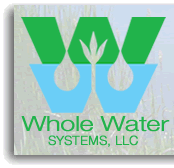Whole Water
Biofiltration Water Treatment Systems
|
Constructed Wetlands |
Recirculating Filter-bed Bioreactor |
Vertical Shaft Activated Sludge 1
|
CWB |
RFB |
VBR (sewage)
|
VBR (biosolids) |
Scale |
Single / cluster / campus |
Single / cluster / campus |
Municipal, large development 2 |
Municipal, large development3 |
Space |
~600sf / single 4 |
Less than CW |
10% – 30% conventional plant 5 |
Energy |
Little to none 6 |
Low7 |
< 50% conventional plant 5 |
Odor |
None, contained8, aerobic |
None, contained, aerobic |
None, contained, aerobic |
Treatment |
EPA Tertiary Standards9 |
EPA Tertiary Standards9 |
EPA Tertiary Standards |
Water Reuse |
Yes |
Yes10 |
Yes11 |
Yes12 |
Energy Recovery |
NA |
NA |
NA |
Yes12 |
Nutrient Recovery |
Optional |
Optional |
Optional |
Yes12 |
Capital Cost |
Low13 |
Low13 |
Low14 |
Low14 |
O&M Cost |
Low13 |
Low 13 |
Low14 |
Low14 |
Aesthetics |
Landscaping amenity |
Unobtrusive, inconspicuous |
Unobtrusive, inconspicuous |
Unobtrusive, inconspicuous |
1. Noram Biosystems Group technology
2. VBR Vertical Shaft Bioreactor, biosolids - sewer treatment systems scale and phase well, starting at relatively large systems for municipal- or large development-scale systems. The VBR technology lends itself to shaft diameters from 18 inches to 22 feet.
3. VBR Vertical Shaft Bioreactor, biosolids - treatment systems can typically service all the biosolids from within a region served by reasonable daily pump truck route distances.
4. CWB constructed wetland systems sizes vary with economies of scale for clustered, campus or commercial building-scale systems. Since plants and landscaping are desirable in all projects and constructed wetlands can be designed as landscaping/architectural amenities, with creative design there is virtually always adequate space.
5. VBR vertical shaft systems utilize typically 10% - 30% the land and less than 50% of the energy required by conventional surface-based activated sludge treatment plants.
6. CWB constructed wetland systems can be entirely passive if topology and gravity can be used. If a lift station is required then only low energy intermittent pumping is required.
7. RFB recirculating filter-bed bioreactor – using Whole Water’s high performance biofiltration treatment system concept – typically uses significantly less energy than other onsite ATU (aerobic treatment unit) alternatives.
8. CWB constructed wetland systems have the water level subsurface with no exposure to the surface. The plant roots make a dense mat preventing access to the effluent and creating an aerobic zone that oxidizes any potential odor before it can reach the surface. In 20 years of installations there have been no incidents of odor from constructed wetlands designed and installed by Whole Water principals.
9. CWB and RFB design options allow for system solutions to meet virtually any level of tertiary treatment performance standards.
10. RFB recirculating gravel bioreactor systems, because they are contained and without plants, these systems retain the most effluent water for reuse (virtually 100%) and are the system of choice among the small-scale systems (CWB & RGF) where quantity of water for reuse is the highest priority.
11.VBR vertical shaft bioreactor, liquid - sewer treatment systems are ideal for “sewer mining” where distributed systems are located along existing sewer main routes in fully contained inconspicuous buildings. Decentralized vertical shaft systems can reduce both the loads on overburdened central sewer plants and the cost of sewage conveyance. It also can afford the opportunity to “mine” the sewage somewhere along the sewer main where there is the opportunity for local beneficial reuse of treated water.
12. VBR Vertical Shaft Bioreactor, biosolids treatment systems can be used to recover three valuable resources that are typically considered “waste” byproducts of biosolids treatment:
- Water – biosolids that are transported to the treatment facility are principally composed of water that can be recovered. While the quantity is obviously significantly less than for the VSL sewer treatment, since the biosolids are transported to the facility, water law considers them unsubscribed – meaning this can be an extremely valuable resource particularly throughout the western U.S. where water rights can largely determine property value and use.
- Energy – the VBR biosolids treatment process is auto-thermophilic (automatically generates 113° F to 176° F temperatures through biological processes) meaning that there is a large amount of thermal energy that can be readily harnessed for beneficial heating use.
- Nutrients – VBR treats biosolids to class A standards meaning that it can be used and sold as organic fertilizer.
13. Whole Water CWB & RFB are decentralized and distributed water treatment systems that when compared with a centralized treatment plant typically have similar (but lower) per capita first costs, but which largely negate the need for the collection and conveyance. Since the EPA estimates that collections systems are typically 70% the cost of conventional systems, Whole Water’s decentralized systems bring significant first cost advantages. Decentralized biological treatment systems are inherently more robust and flexible than conventional treatment plants and as a result their operation & maintenance costs are significantly less. |


